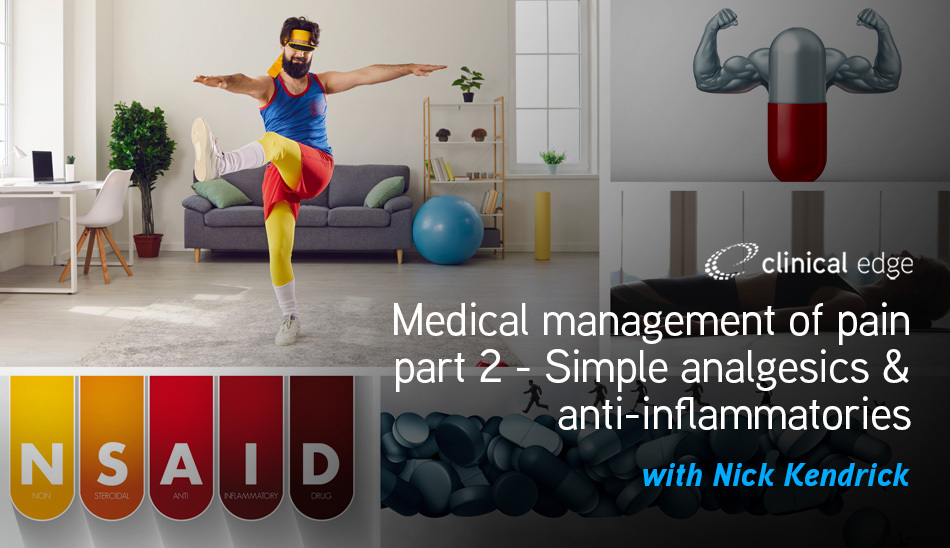Simple analgesics such as non-steroidal anti-inflammatory drugs (NSAID’s), paracetamol/acetaminophen, and steroidal anti-inflammatories are some of the most common medications our patients are taking for pain relief. Some of these medications may be prescribed and monitored by their GP, or our patients may be self-administering these medications and experiencing side-effects their GP is completely unaware of.
Patients self-administering medications may have more effective medical treatment options available they don’t know exist, and will benefit from your referral for a medical review.
Now available - 18. Medical management of pain part 2 - Simple analgesics & anti-inflammatories with Nick Kendrick

In this Clinical Edge presentation “The drugs don’t work. Or do they?” part 2 - Simple analgesics, Nick Kendrick (APA Titled Musculoskeletal and Sports & Exercise Physiotherapist) will help you understand and explain simple analgesics to your patients, as he reveals:
Paracetamol/Acetaminophen
- The lowdown, uses and risks with Paracetamol/Acetaminophen
- What the evidence really shows about Paracetamol for acute and chronic low back pain, headaches and knee osteoarthritis (OA).
- Benefits & risk of codeine based medications, and why these have recently been changed to prescription only in Australia and many other countries, rather than over the counter medications.
NSAID’s
NSAID’s are one of the most common medications your patients in pain may be taking, but have serious side effects and may slow your patients recovery from injury. In this section you’ll learn:
-
Common NSAID’s your patients will be taking for pain,
-
When and how different NSAID’s may be used, including:
- Aspirin
- Ibuprofen
- Naproxen
- Diflunisal
- Diclofenac
- Indomethacin
- Piroxicam
- Meloxicam and
- Celecoxib.
-
How NSAID’s work.
-
The difference between selective (COX-2) inhibitors such as Meloxicam (Mobic) and non-selective NSAID’s such as Ibuprofen, and the risks and benefits of each.
-
Why selective and non-selective NSAID’s should not be combined.
-
Why selective COX-2 NSAID’s became popular.
-
Serious risks and adverse effects of COX2 inhibitors.
-
How to identify when NSAIDs are interfering with your patient’s injury recovery.
-
Why your patient's medical team may want to use NSAID’s to inhibit bone growth.
-
Three top tips for patients that are applying topical Ibuprofen.
NSAID’s & muscle, tendon & ligament injuries
Patients may believe they’re helping to stop swelling or improve their recovery by taking NSAID’s following muscle, tendon & ligament injuries. Find out whether NSAID’S are really helping or harming your injured patients recovery, including:
- Whether NSAID’s should be taken following injury, or if they limit healing and recovery.
- Effect of NSAIDs on ligament and muscle healing.
- Whether NSAID’s are suitable for muscle contusion injuries.
- Whether NSAID’s can be used for post-exercise DOMS.
- Are NSAID’s helpful in tendinopathy and tendon injuries?
- What is the tendon Poly-Pill, and how it can be used with tendinopathy patients.
- Synovium - which NSAIDs for DeQuervain’s or other tenosynovitis?
Steroidal anti-inflammatories
Patients may receive steroidal anti-inflammatories such as Prednisone for inflammatory conditions or low back pain. In this section you’ll discover:
- Why steroidal anti-inflammatories such as Prednisone may be prescribed for your patients.
- The different types of steroidal anti-inflammatories, how they work and are administered.
- Risks and adverse effects from corticosteroids to watch for in your patients.
Opioids
Opioids such as codeine, oxycodone and tramadol are commonly prescribed for pain management, but have many side effects you can help to identify.
- Different types of opioids including codeine, oxycodone, hydrocodone, tramadol, fentanyl and tapentadol,
- Whether opioids are useful in chronic low back pain or neuropathic pain.
- Adverse effects and serious adverse effects to watch for in your patients.
- How to identify patients that may be ultra-metabolisers, and why they may be unwittingly more susceptible to opioid overdose.
- Tramadol - dangers of use in combination with other medications.
- Serotonin syndrome.
- Hunter criteria.
- How to test if patients have had a reaction to a combination of opioids and other medications.
Muscle relaxants and benzodiazepines
Patients with pain, especially long term pain, and associated anxiety may be prescribed muscle relaxants such as tizanidine & benzodiazepines eg diazepam. Discover when these drugs may be helpful, and when your patients are experiencing side effects. You’ll explore:
- Diazepam - Why it is used in low back pain patients, effects and adverse effects
- Muscle relaxants including Carisoprodol, Cyclobenzaprine, Metaxalone, Tizanidine, Methocarbamol, and Baclofen.
- How they work, and why they are prescribed in patients with musculoskeletal pain, even though they have no pain relieving effect.
Improve your knowledge and understanding of simple analgesics now, so you can understand and explain simple analgesics to your patients. Identify patients experiencing side-effects from their medications, and patients that may benefit from you referring them for a medical review.
CLICK HERE to improve your assessment & diagnostic skills with a free trial Clinical Edge membership
